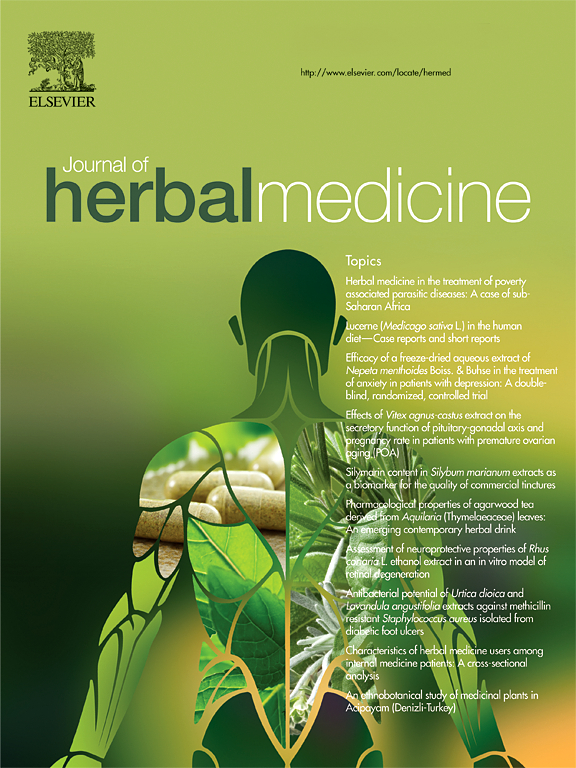网络药理学与分子对接分析揭示黄花蒿治疗系统性红斑狼疮的潜力
IF 1.9
4区 医学
Q2 INTEGRATIVE & COMPLEMENTARY MEDICINE
引用次数: 0
摘要
黄花蒿(artemisia annua L.)是一种传统中药,已被用于治疗炎性疾病,包括系统性红斑狼疮(SLE)。然而,其治疗SLE的活性成分和分子机制尚不清楚。方法采用中药系统药理学数据库和分析平台,以药物相似度≥0.18、口服生物利用度≥30%为标准对活性化合物进行鉴定。通过搜索词“系统性红斑狼疮”,从DrugBank、在线孟德尔遗传(Online Mendelian Inheritance in Man)、Therapeutic Target Database和GeneCards检索sle相关基因。使用Search Tool for Retrieval of Interacting Genes/Proteins构建蛋白-蛋白互作网络,通过DAVID平台进行京都基因与基因组百科全书和基因本体富集分析。利用AutoDock软件进行分子对接。结果通过拓扑分析鉴定出8个核心疾病相关基因和5个关键活性化合物。基因本体论和京都基因和基因组百科分析表明,这些化合物主要影响癌症发展风险、细胞死亡的负调控以及相关的信号通路。分子对接证实了关键植物化学物质与SLE核心靶点之间具有很强的结合亲和力。结论本研究发现的活性化合物靶向以下基因:白细胞介素-6、肿瘤蛋白p53、表皮生长因子受体、蛋白激酶B、白细胞介素-1 β、肿瘤坏死因子、原癌基因和B细胞淋巴瘤2,这些基因调节炎症、t细胞分化和凋亡。这些发现表明,黄花蒿是SLE多靶点治疗药物的来源,需要进一步的实验验证。本文章由计算机程序翻译,如有差异,请以英文原文为准。
Network Pharmacology and Molecular Docking Analysis Reveal the Therapeutic Potential of Artemisia annua L. in Systemic Lupus Erythematosus
Introduction
Artemisia annua L., a traditional Chinese herb, has been used to manage inflammatory diseases, including systemic lupus erythematosus (SLE). However, its active components and molecular mechanisms in treating SLE remain unclear.
Methods
Active compounds were identified using the Traditional Chinese Medicine Systems Pharmacology Database and Analysis Platform with criteria of drug-likeness ≥0.18 and oral bioavailability ≥30%. SLE-related genes were retrieved from DrugBank, Online Mendelian Inheritance in Man, Therapeutic Target Database, and GeneCards using the search term ‘systemic lupus erythematosus.’ Protein–protein interaction networks were constructed using Search Tool for the Retrieval of Interacting Genes/Proteins, and the Kyoto Encyclopaedia of Genes and Genomes and Gene Ontology enrichment analyses were performed via the DAVID platform. Molecular docking was conducted using AutoDock software.
Results
Eight core disease-related genes and five key active compounds were identified through topological analysis. Gene ontology and kyoto encyclopaedia of genes and genomes analyses indicated that the compounds primarily influenced cancer development risk, negative regulation of cell death, and related signalling pathways. Molecular docking confirmed strong binding affinities between key phytochemicals and core SLE targets .
Conclusions
The active compounds identified in this study target the following genes: interleukin-6, tumour protein p53, epidermal growth factor receptor, protein kinase B, interleukin-1 beta, tumour necrosis factor, jun proto-oncogene, and B-cell lymphoma 2, which regulate inflammation, T-cell differentiation, and apoptosis. These findings suggest Artemisia annua L. is a source of multitarget therapeutic agents for SLE, warranting further experimental validation.
求助全文
通过发布文献求助,成功后即可免费获取论文全文。
去求助
来源期刊

Journal of Herbal Medicine
INTEGRATIVE & COMPLEMENTARY MEDICINE-
CiteScore
3.90
自引率
0.00%
发文量
94
期刊介绍:
The Journal of Herbal Medicine, the official journal of the National Institute of Medical Herbalists, is a peer reviewed journal which aims to serve its readers as an authoritative resource on the profession and practice of herbal medicine. The content areas of the journal reflect the interests of Medical Herbalists and other health professionals interested in the clinical and professional application of botanical medicines. The objective is to strengthen the research and educational base of herbal medicine with research papers in the form of case studies, original research articles and reviews, monographs, clinical trials and relevant in vitro studies. It also publishes policy statements, opinion pieces, book reviews, conference proceedings and profession related information such as pharmacovigilance reports providing an information source for not only the Herbal Practitioner but any Health professional with an interest in phytotherapy.
 求助内容:
求助内容: 应助结果提醒方式:
应助结果提醒方式:


